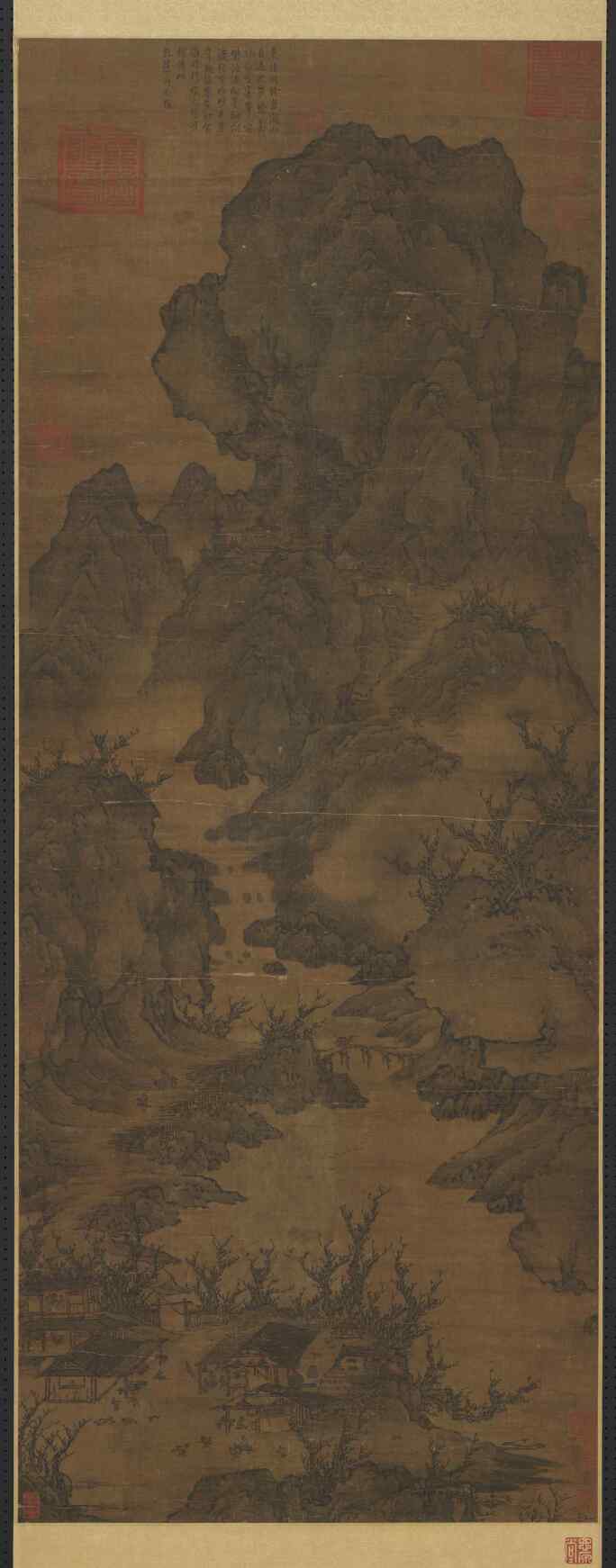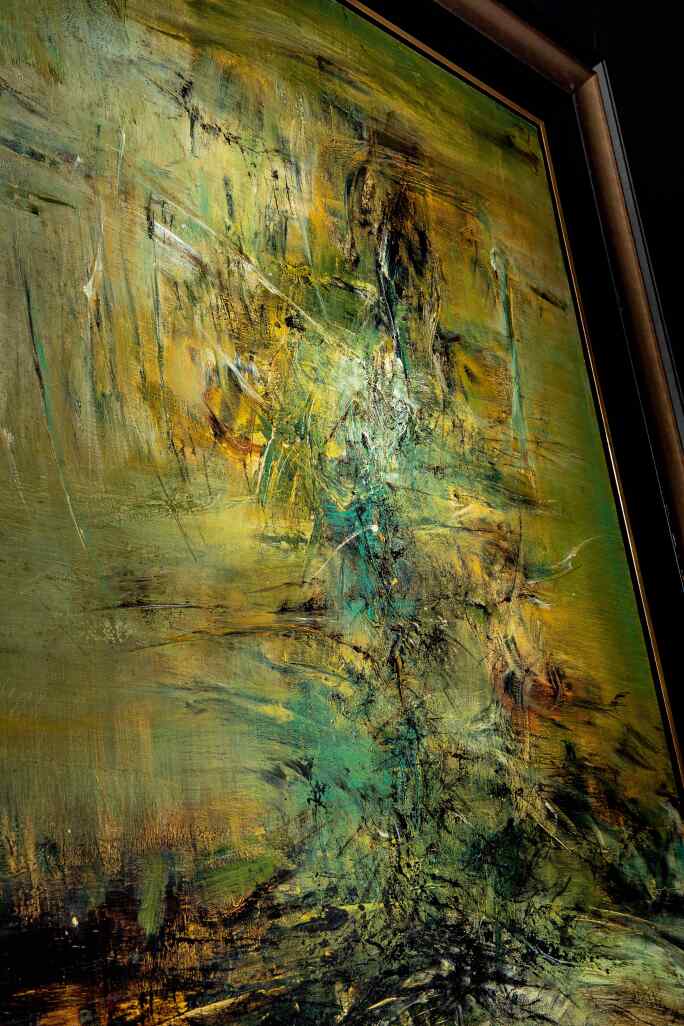"I want to depict movement, whether lingering in one place or flying fast as lightning. The multiple resonances of contrasting and identical colors make the canvas vibrate, allowing me to find a central, glowing point. My brush moves freely, and sometimes I use a palette knife to press the paint onto the canvas, as if I wanted the paint to penetrate the space."
B lazing with potent intensity and coruscating resplendence, 14.05.63 is an exceptional work by Zao Wou-Ki executed during his celebrated Hurricane Period. Searing crevices of pearlescent white and turquoise pierce through layers and chasms of bronze and earth tones, manifesting a graceful and powerful maelstrom of color and light. Reverberating with a transcendent aura, 14.05.63 orchestrates a tempestuous symphony between line and form, color and contour, culminating in an intoxicating vibrating atmosphere defined by concentrated intuition and meticulous precision. Confidently and brilliantly executed, 14.05.63summons the same overpowering immediacy and visual authority as it did over half a century ago.

Zao Wou-Ki's artistic career reached a new pinnacle in the 1960s. During the late 1950s, he decided to reject his previous artistic achievements by forsaking realistic representation, this change being inspired by Northern Song master Fan Kuan's axiom: “It is better to learn from Nature than from ancient masters; it is even better to learn from your own heart than from Nature”. Zao plumbed the depths of his inner being for inspiration, extending and fusing color palettes in pursuit of an infinite, abstract world on canvas. He contemplated the many-faceted issues surrounding the universe, portraying things that are not even visible to the naked eye: elements such as qi (energy), winds, the power and physicality of life, as well as his own personal feelings. The ensuing Hurricane Period marked the beginning of a golden era, from which 14.05.63 is a classic paradigm. With depictions of space rooted in traditional Eastern concepts of landscape painting as well as modern abstract aesthetics, Zao’s colors and lines appear to echo the energy of nature and the universe. Around the time 14.05.63 was painted, Zao had moved away from his earlier habit of using a round brush, opting instead for the wide, flat brush and palette knife. With these tools, Zao blended the grace of Eastern brushwork and the grandeur of Northern Song landscapes with the power and texture of densely layered Western oil painting.

The compositions of Zao’s work from the 1960s draw on horizontal and vertical scrolls or diagonal interlocking compositions, and 14.05.63 is representative of his vertical mountain compositions. In “An Essay on Landscape Painting” (Linquan Gaozhi), Northern Song literatus Guo Xi wrote: “When planning to paint, one should create a harmonious relationship between heaven and earth. What do we mean by heaven and earth? Take for example a composition of a foot and a half long. The upper part is heaven, the lower part the earth. The artist must arrange his ideas and design the scenery and fit them into the space between them” (Guo, Xi, An Essay on Landscape Painting, translated by Shio Sakanishi, London: J. Murray, 1935). 14.05.63 echoes these spatial and compositional principles of Chinese painting; through color, the image divides into spatial associations with heaven above and earth below. Zao arranged his lines and “designed his scenery” in this central portion: these lines – at once converging, diverging, quivering, and layering – are reminiscent of the freedom and energy of “wild” cursive (kuangcao) calligraphy. The irrepressible dynamism of the work springs from the same source as mist blanketing an alpine range, a winding ascent to a mountain peak, tender shoots of life breaking through the soil, or even the opening of the universe.

The color placement of 14.05.63 stems from Zao Wou-Ki’s deep respect for traditional Chinese aesthetics. Light and dark greens are the main colors, giving the piece an immortal, grand beauty like an ancient bronze vessel. With deep ink colors surging upwards from the lower part of the painting, the two intensely contrasting colors meet, collide, and entangle at the center, sparring against each other with brilliant audacity. The line, color, and composition of the work recreate the forms of heaven, earth, and mountains; at the same time, they also represent the dynamism of forces that have no form – i.e., wind, air, and mist. The spatial structure inspires associations with abundance, nature, and vitality, all of which 14.05.63 expresses. Through the forms of mountains and rivers, Zao Wou-Ki depicts changes in the universe and the vibrations of life, offering a boundless vision of the natural world.
Numerous artists and critics have praised Zao's output of the 1960s. During the early 1960s, Alfred Manessier (1962 winner of the Venice Biennale Grand Prix) wrote in a letter to Zao: “I listen quietly, opening my heart, grasping those important messages you're communicating through your drawings ... your works are beautiful, they've surpassed your fluid technique. I think I can say this: your paintings now are ever more realistic, they have surpassed everything you've painted befor” (Zao Wou-Ki & Françoise Marquet, ed., Zao Wou-Ki, Autoportrait, Artist Publishing Co., Taipei, 1992, p. 120). During this decade, Zao’s French agent – Myriam Prévot from the Galerie de France – organized exhibitions in galleries and museums at home and abroad, further elevating his international profile. Zao was displayed alongside such Abstract Expressionists as Hans Hartung and Pierre Soulages, establishing him as a member of that generation of artists as they came to the fore. Other celebrated agents such as Samuel Kootz and Pierre Matisse also sought to establish long-term working relationships with Zao, demonstrating the power and immediacy of his art, and how his aesthetics transcended barriers of nationality, identity and language.
「要看的是空間:空間的伸展、扭轉,我常在心裡揣摩的是:如何畫風?怎樣表現空白?表現光的明朗、純淨?」

六〇年代起,趙無極的繪畫事業展開全新格局,立足東方傳統山水理念與現代抽象美學想像,聚焦畫面的空間表現,用色彩與線條開拓一派馳騁於大自然與宇宙間的自由之氣,攜全新「狂草系列」開啟事業黃金年代,《14.05.63》即為藝術家此時期之經典代表,創作之時,趙無極一改五〇年代慣用的圓筆作畫方式,換用寬扁的排筆和畫刀等為工具,融合光色、揮舞線條,在西方濃厚的油彩堆疊之中糅合東方筆道之力度與北宋山水之氣度,營造蒼勁雄渾的色彩構架,行筆之間盡顯匯合東西文化的奔放與自信之情。
縱觀趙無極六〇年代作品,其構圖大抵採取橫軸、豎軸、亦或是對角線交錯佈局,《14.05.63》即為縱向山脊式構圖之箇中代表。北宋郭熙在《林泉高致》畫論裡曾提及構圖:「凡經營下筆,必合天地。何謂天地?謂如一尺半幅之上,上留天之位,下留地之位,中間方立意定景。」《14.05.63》隱然呼應著上述中國繪畫的空間構圖原則,以色彩把畫面分割為上天下地的空間聯想,再在中心位置鋪陳筆觸線條,立意定景。線條之間拼合、斷裂、躍動、交疊錯綜,彷佛狂草書法的自由揮灑,氣勢磅礡。其破竹之動勢,模擬著山巒嵐氣在千岩萬壑間遊轉,或是山峰蜿蜒攀升之態,甚至如天地開闢,生命動能破土而出。
畫面色彩之鋪陳,流淌著趙無極心底對於東方美學元素的崇敬。深淺不一的綠色構成畫面主色譜,呈現一種猶如青銅古器般不朽且大氣之美,墨色深邃則由畫面下方向上翻湧,兩股色彩對比強烈,在畫面中心遇合、碰撞、交纏,迸發出源源不絕的生命氣魄。畫面無論是線條、色彩,乃至構圖,都不單純模擬天地山脊之外形,而是呈現風、氣、雲霧等無形洶湧之動勢與生機,空間結構令觀者產生波瀾壯闊自然生命的聯想,這正是《14.05.63》所表達之主旨——以山水之形,寫天地變動與生命震顫,在有限的空間內呈現對自然界的無盡想像。